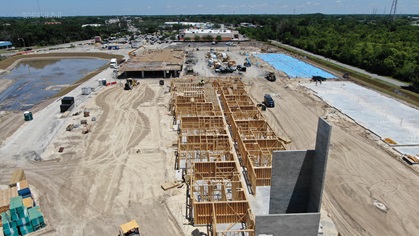City drone keeps inspectors safe
Staff finds new uses for UAS
A Florida Gulf Coast city started with a simple goal: Reduce the risks associated with climbing ladders to conduct building inspections. Experience has shown that drones can do that, and much more.
Falls are among the leading causes of workplace injuries and fatalities, and accounted for 17 percent of all on-the-job deaths in 2017, according to data compiled by the federal Bureau of Labor Statistics. The 887 lives lost in 2017 marked an all-time high in the 26-year history of the Census of Fatal Occupational Injuries.
“There were some places we just couldn’t access safely,” Gilson recalled in a recent telephone interview. “Unfortunately, things weren’t being looked at as well as they could be.”
Gilson, now in his fifth year on the city staff, said the arrival of Building Development Director Kevin Powell marked a shift in attitude from being unwilling to risk the potential downsides of drones, including privacy concerns, to being willing to “stick a toe in the water.” Gilson drafted a policy on drone use by city officials long before the first drone flew earlier this year, and wound up poaching the city arborist from another department and setting her up with training. That’s Shannon Brewer, who brought no aviation experience to her new role as a remote pilot, but has become an accomplished, careful, and enthusiastic pilot of quadcopters such as the DJI Mavic 2 Zoom.
“I’m the local tree hugger,” Brewer explained. Her own interest in drones was inspired in part by an enforcement case involving illegal deforestation, regulations that were difficult to enforce without a very expensive survey conducted by contractors. Brewer was in the market for a better solution, and Gilson had just the thing. “It just melded perfectly,” Brewer recalled.
Brewer trained with a combination of self-directed study and Gilson’s mentorship, and got the hang of the thumb sticks flying at local athletic fields. She passed the FAA test and soon found herself flying a construction project next to a local hospital with Gilson helping to keep a watchful eye out for helicopter traffic that occasionally uses the uncharted helipad. They discovered that the zoom capability allows the drone to remain well clear of obstacles but still capture high levels of detail in the images, such as digits stamped on rivets visible from 25 feet away.

Results like that quickly dispelled concern that a drone was not an adequate substitute for a person perched atop a ladder, sometimes a very tall ladder. Brewer found that mapping missions are also useful for spotting tree diseases when they can be (forgive me) nipped in the bud. Brewer is now available on call for inspection jobs of various kinds, and said her newly developed skills also add an element of fun to her job, though she remains focused on safety first and foremost.
“What makes flying fun is the challenge,” Brewer wrote in a follow-up email. “It is not hard work, it is challenging work. Having to be on top of all factors simultaneously (the completion of the assigned task, environmental influences, non-participants of the flight, obstructions, etc.) is exhilarating.”
Brewer said the Part 107 remote pilot exam was challenging, particularly when it came to some of the more arcane elements such as decoding a metar:
“The remote pilot test is relevant because it makes the drone operator become aware and comprehend that a drone is more than a flying robot. Drone work has become an industry. There needs to be industry standards and the test is the enforcement tool. I don’t mean enforcement in a condescending tone either. It is a necessity to ensure proper operations and ethics are followed for the protection of the client/resident and the pilot.”
Gilson said local police have their own drone program for public safety applications. The increasing use of drones by City Hall staff has generated buzz in the community.
“People are just excited about it,” Gilson noted, noting the policy he crafted, which includes an opt-out option available to anyone who prefers to have their inspections done the old-fashioned way, has made it clear to the community that the quadcopters are not spying, they’re doing good and useful work that saves tax dollars and reduces risk to people. Other departments have begun to inquire about enlisting Brewer.
“Once you understand the capabilities then your mind starts running away,” Gilson said. “I’m sure it’s going to bleed into some kind of a marketing thing. This started with safety and then we’re finding it’s more than safety now. We’re seeing things we didn’t used to be able to see. It’s starting to have a rapid cascade effect.”




